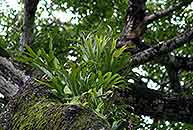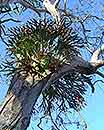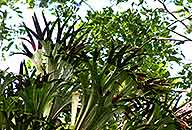Platycerium alcicorne Desv.
Synonyms |
Elaphoglossum alcicorne (Desv.) Keyserl. |
|---|---|
Common name |
|
Description |
Rhizome short, c. 1 cm in diameter, rhizome scales brown, subulate, 3.5-12 x 0.5-1.5 mm. Fronds dimorphous. Sterile fronds 20-35 x 8-25 cm, round to reniform, convex, notched at the base and overlapping, forming at maturity an almost hemispherical mass, thinly set with minute hairs, becoming glabrous with age. Fertile fronds up to 60 cm long, narrowly wedge-shaped, reduced towards the base into a short and thick petiole, 2-4 times dichotomously branched, divided into rounded to bluntly pointed segments up to 30 × 2.5 cm, subglabrous above, densely set with minute stellate hairs below. Soral patches generally several per frond (4-8) on the underside of the lamina near but not at the apices of the ultimate lobes; initially median on the segment, reaching from margin to margin and down to the sinus when mature, never covering the segment apex; covered with white stellate hairs. |
Notes | This species has been listed as extinct in Zimbabwe due to habitat loss and overcollecting. However we found a specimen very high in an old Albizia adiantifolia and it seems rather unlikely that the specimen was planted there. Although the tree was growing at the edge of a tea plantation, it was not particularly close to any buildings or gardens. When we asked the guides at Aberfoyle about this species they were confident that they had seen more specimens in the area. It would be very good to find if more specimens of this species might have been able to survive in Zimbabwe but more investigation is needed to confirm or deny this. |
Derivation | alcicorne: alces: the generic name of an elk, cornu: horn; translating to the common name 'elkhorn'. |
Habitat | Deciduous woodland or dry, semi-deciduous forest, evergreen thickets, on Diospyrus mespiliformis and Ficus as solitary trees in cultivations, exposed or partially shaded. |
Distribution worldwide | Africa, Comoro Isl., Madagascar, Mauritius, Réunion, Seychelles. |
Distribution in Africa |
|
Growth form |
Epiphytic. |
Literature |
|





